
USS Patoka (AO–9/AV–6/AG–125) was a replenishment oiler made famous as a tender for the airships Shenandoah (ZR-1), Los Angeles (ZR-3) and Akron (ZRS-4). It was also notable in that its height figured prominently in the design of the Rainbow Bridge in Texas.
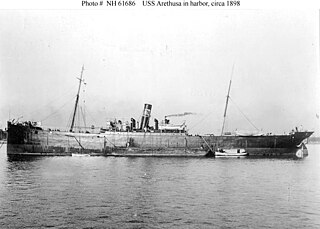
USS Arethusa (AO-7) was a steamship that was built in England in 1893 as the civilian oil tanker Luciline. The United States Navy bought her in 1898, and later had her converted into a Fleet oiler. She was sold back into civilian ownership in 1927,and by 1928 she was a civilian hulk in Boston.

USS Alameda, was a United States Navy tanker in commission from 1919 to 1922. She was built as the civilian tanker SS Alameda, but transferred to the U.S. Navy after completion in 1919. She was sold for commercial service and operated under the names SS Olean and SS Sweep before she was transferred to the Navy again in World War II as USS Silver Cloud (IX-143).

USS Sapelo (AO-11) was a Patoka-class fleet replenishment oiler of the United States Navy. Laid down on 3 May 1919 for the United States Shipping Board by the Newport News Shipbuilding and Dry Dock Co., Newport News, Virginia, the ship was launched on 24 December 1919, transferred to the Navy on 30 January 1920, and commissioned on 19 February 1920.

USS Laramie (AO-16) was a Kaweah-class fleet replenishment oiler in the United States Navy.

USS Mattole (AO‑17) was a Kaweah-class fleet replenishment oiler in the United States Navy.

USS Rapidan (AO-18), was a US Navy tanker of World War II.

USS Salinas (AO-19), a United States Navy Patoka-class replenishment oiler, was laid down for the United States Shipping Board (USSB) as Hudsonian (219592) on 10 April 1919 by the Newport News Shipbuilding and Dry Dock Co., Newport News, Virginia; launched on 5 May 1920; accepted by the USSB on 13 May 1920; transferred to the Navy on 29 October 1921; renamed Salinas and designated AO-19 on 3 November 1921; and commissioned at Mobile, Ala., on 16 December 1921.

USS Nantahala (AO–60), the second ship of this name, was laid down under Maritime Commission contract by Bethlehem Sparrows Point Shipyard, Inc., Sparrows Point, Maryland, on 31 October 1943. Launched on 29 April 1944; sponsored by Miss Mary Louise Reed; delivered to the Navy 19 June 1944; and commissioned the same day.

USS Noxubee (AOG-56) was a Patapsco-class gasoline tanker acquired by the U.S. Navy for the task of transporting gasoline to warships in the fleet, and to remote Navy stations. She served in a commissioned status from 1945 to 1959, and 1965–1975. She was named for a river in Mississippi.
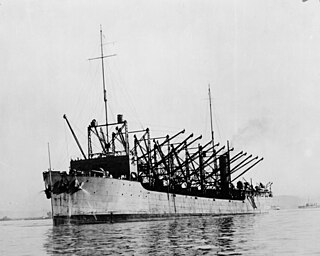
The collier USS Proteus (AC-9) was laid down on 31 October 1911, by the Newport News Shipbuilding and Dry Dock Company, and launched on 14 September 1912. She was the lead ship of her class of four colliers. She was commissioned on 9 July 1913, to the United States Navy.

USS Kankakee (AO-39) was a Kennebec-class fleet oiler of the United States Navy. The ship was built as SS Colina by Bethlehem Steel Co., Sparrows Point, Maryland, launched on 24 January 1942, sponsored by Mrs. D. A. Little, acquired for the Navy on 31 March through the Maritime Commission from her owner, Socony-Vacuum Oil Company, New York City, and commissioned as Kankakee at Norfolk, Virginia, on 4 May.
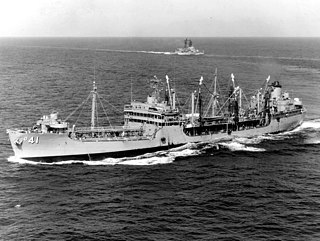
USS Mattaponi (AO-41) was a Kennebec-class oiler which served in the United States Navy during World War II, periodically during the 1950s, and in the Vietnam War. She was the only U.S. Navy ship named for the Mattaponi River in eastern Virginia.

The second USS Monongahela (AO-42) was a Kennebec-class oiler in the United States Navy which saw service during World War II and the Korean War. She was the second U.S. Navy ship named for the Monongahela River in West Virginia and Pennsylvania.

USS Waccamaw (AO-109) was a Cimarron-class replenishment oiler in the United States Navy. She was named after Waccamaw River. The original capacity was 146,000 barrels (23,200 m3).

The third USS Neptune (AC–8), a collier of the U.S. Navy, was laid down by the Maryland Steel Co., Sparrows Point, Md. 23 March 1910; launched 21 January 1911; and placed in service with a merchant crew at Norfolk Navy Yard 20 September 1911.

USS Elokomin (AO-55) was a Cimarron-class fleet oiler acquired by the U.S. Navy during World War II. She served her country primarily in the Atlantic Ocean, Mediterranean Sea, and the North Atlantic Ocean Theatre of Operations, and provided petroleum products where needed to combat ships.
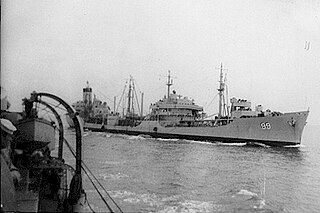
USS Canisteo (AO-99) was a Cimarron-class fleet oiler constructed for the United States Navy in the closing days of World War II. Commissioned too late for service in that conflict, she had a lengthy career in the Cold War that followed. She was the only U.S. Navy ship to bear the name Canisteo, after the Canisteo River in New York.
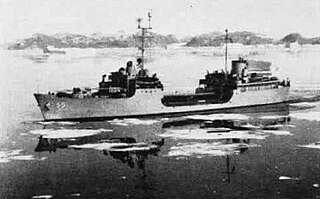
USS Nespelen (AOG-55) was a Patapsco-class gasoline tanker in the service of the United States Navy.

USS Truckee (AO-147) was a Neosho-class fleet oiler of the United States Navy in service from 1955 to 1994. The ship was named after the Truckee River in the U.S. states of California and Nevada.




















